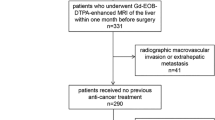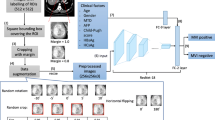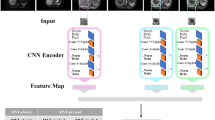Abstract
Purpose
To investigate the value of a multimodal deep learning (MDL) model based on computed tomography (CT) and magnetic resonance imaging (MRI) for predicting microvascular invasion (MVI) in hepatocellular carcinoma (HCC).
Methods
A total of 287 patients with HCC from our institution and 58 patients from another individual institution were included. Among these, 119 patients with only CT data and 116 patients with only MRI data were selected for single-modality deep learning model development, after which select parameters were migrated for MDL model development with transfer learning (TL). In addition, 110 patients with simultaneous CT and MRI data were divided into a training cohort (n = 66) and a validation cohort (n = 44). We input the features extracted from DenseNet121 into an extreme learning machine (ELM) classifier to construct a classification model.
Results
The area under the curve (AUC) of the MDL model was 0.844, which was superior to that of the single-phase CT (AUC = 0.706–0.776, P < 0.05), single-sequence MRI (AUC = 0.706–0.717, P < 0.05), single-modality DL model (AUCall-phase CT = 0.722, AUCall-sequence MRI = 0.731; P < 0.05), clinical (AUC = 0.648, P < 0.05), but not to that of the delay phase (DP) and in-phase (IP) MRI and portal venous phase (PVP) CT models. The MDL model achieved better performance than models described above (P < 0.05). When combined with clinical features, the AUC of the MDL model increased from 0.844 to 0.871. A nomogram, combining deep learning signatures (DLS) and clinical indicators for MDL models, demonstrated a greater overall net gain than the MDL models (P < 0.05).
Conclusion
The MDL model is a valuable noninvasive technique for preoperatively predicting MVI in HCC.





Similar content being viewed by others
Data availability
The study subjects or cohorts in our study have not been previously reported.
Abbreviations
- ACC:
-
Accuracy
- AFP:
-
α-Fetoprotein
- ALP:
-
Alkaline phosphatase
- ALT:
-
Alanine aminotransferase
- AP:
-
Arterial phase
- AST:
-
Aspartate aminotransaminase
- AUC:
-
Area under the ROC curve
- CA19-9:
-
Carbohydrate antigen 19-9
- DBIL:
-
Direct bilirubin
- DCA:
-
Decision curve analysis
- DL:
-
Deep learning
- DLS:
-
Deep learning signatures
- DP:
-
Delayed phase
- ELM:
-
Extreme learning machine
- IBIL:
-
Indirect bilirubin
- IDI:
-
Integrated discrimination improvement
- IP:
-
In-phase
- MMD:
-
Maximum mean discrepancy
- NPV:
-
Negative predictive value
- OP:
-
Opposed-phase
- OS:
-
Overall survival
- PCP:
-
Precontrast phase
- PLT:
-
Platelet count
- PPV:
-
Positive predictive value
- PVP:
-
Portal venous phase
- ROC:
-
Receiver operating characteristic
- ROI:
-
Region of interest
- SEN:
-
Sensitivity
- SPC:
-
Specificity
- T2WI:
-
T2-weighted imaging
- TACE:
-
Transarterial chemoembolization
- TBIL:
-
Total bilirubin
References
Lim K-C, Chow PK-H, Allen JC, et al (2011) Microvascular Invasion Is a Better Predictor of Tumor Recurrence and Overall Survival Following Surgical Resection for Hepatocellular Carcinoma Compared to the Milan Criteria. Ann Surg 254:108–113. https://doi.org/10.1097/SLA.0b013e31821ad884
Shi M, Guo R-P, Lin X-J, et al (2007) Partial Hepatectomy With Wide Versus Narrow Resection Margin for Solitary Hepatocellular Carcinoma: A Prospective Randomized Trial. Ann Surg 245:36–43. https://doi.org/10.1097/01.sla.0000231758.07868.71
Yamashita Y, Tsuijita E, Takeishi K, et al (2012) Predictors for Microinvasion of Small Hepatocellular Carcinoma ≤2 cm. Ann Surg Oncol 19:2027–2034. https://doi.org/10.1245/s10434-011-2195-0
Shindoh J, Andreou A, Aloia TA, et al (2013) Microvascular Invasion Does Not Predict Long-Term Survival in Hepatocellular Carcinoma up to 2 cm: Reappraisal of the Staging System for Solitary Tumors. Ann Surg Oncol 20:1223–1229. https://doi.org/10.1245/s10434-012-2739-y
Hidaka M, Eguchi S (2018) Impact of Anatomical Resection for Hepatocellular Carcinoma with Micro-portal Invasion (vp1): A Multi-institutional Study by the Kyushu Study Group of Liver Surgery. HPB 20:S391. https://doi.org/10.1016/j.hpb.2018.06.2692
Peng Z, Chen S, Xiao H, et al (2019) Microvascular Invasion as a Predictor of Response to Treatment with Sorafenib and Transarterial Chemoembolization for Recurrent Intermediate-Stage Hepatocellular Carcinoma. Radiology 292:237–247. https://doi.org/10.1148/radiol.2019181818
Mazzaferro V, Llovet JM, Miceli R, et al (2009) Predicting survival after liver transplantation in patients with hepatocellular carcinoma beyond the Milan criteria: a retrospective, exploratory analysis. Lancet Oncol. 2009 Jan;10(1):35-43. doi: https://doi.org/10.1016/S1470-2045(08)70284-5
Lee S, Kim SH, Lee JE, et al (2017) Preoperative gadoxetic acid–enhanced MRI for predicting microvascular invasion in patients with single hepatocellular carcinoma. J Hepatol 67:526–534. https://doi.org/10.1016/j.jhep.2017.04.024
Banerjee S, Wang DS, Kim HJ, et al (2015) A computed tomography radiogenomic biomarker predicts microvascular invasion and clinical outcomes in hepatocellular carcinoma. Hepatology 62:792–800. https://doi.org/10.1002/hep.27877
Kim H, Park M-S, Choi JY, et al (2009) Can microvessel invasion of hepatocellular carcinoma be predicted by pre-operative MRI? Eur Radiol 19:1744–1751. https://doi.org/10.1007/s00330-009-1331-8
Ahn SY, Lee JM, Joo I, et al (2015) Prediction of microvascular invasion of hepatocellular carcinoma using gadoxetic acid-enhanced MR and 18F-FDG PET/CT. Abdom Imaging 40:843–851. https://doi.org/10.1007/s00261-014-0256-0
Ariizumi S, Kitagawa K, Kotera Y, et al (2011) A non‐smooth tumor margin in the hepatobiliary phase of gadoxetic acid disodium (Gd‐EOB‐DTPA)‐enhanced magnetic resonance imaging predicts microscopic portal vein invasion, intrahepatic metastasis, and early recurrence after hepatectomy in patients with hepatocellular carcinoma. J Hepato Biliary Pancreat 18:575–585. https://doi.org/10.1007/s00534-010-0369-y
Martinino A, Aloulou M, Chatterjee S, et al (2022) Artificial Intelligence in the Diagnosis of Hepatocellular Carcinoma: A Systematic Review. JCM 11:6368. https://doi.org/10.3390/jcm11216368
Wang K, Lu X, Zhou H, et al (2019) Deep learning Radiomics of shear wave elastography significantly improved diagnostic performance for assessing liver fibrosis in chronic hepatitis B: a prospective multicentre study. Gut 68:729–741. https://doi.org/10.1136/gutjnl-2018-316204
Yasaka K, Akai H, Abe O, Kiryu S (2018) Deep Learning with Convolutional Neural Network for Differentiation of Liver Masses at Dynamic Contrast-enhanced CT: A Preliminary Study. Radiology 286:887–896. https://doi.org/10.1148/radiol.2017170706
Xu X, Zhang H-L, Liu Q-P, et al (2019) Radiomic analysis of contrast-enhanced CT predicts microvascular invasion and outcome in hepatocellular carcinoma. J Hepatol 70:1133–1144. https://doi.org/10.1016/j.jhep.2019.02.023
An C, Kim DW, Park Y-N, et al (2015) Single Hepatocellular Carcinoma: Preoperative MR Imaging to Predict Early Recurrence after Curative Resection. Radiology 276:433–443. https://doi.org/10.1148/radiol.15142394
Chong H-H, Yang L, Sheng R-F, et al (2021) Multi-scale and multi-parametric radiomics of gadoxetate disodium–enhanced MRI predicts microvascular invasion and outcome in patients with solitary hepatocellular carcinoma ≤ 5 cm. Eur Radiol 31:4824–4838. https://doi.org/10.1007/s00330-020-07601-2
Feng S-T, Jia Y, Liao B, et al (2019) Preoperative prediction of microvascular invasion in hepatocellular cancer: a radiomics model using Gd-EOB-DTPA-enhanced MRI. Eur Radiol 29:4648–4659. https://doi.org/10.1007/s00330-018-5935-8
Ma X, Wei J, Gu D, et al (2019) Preoperative radiomics nomogram for microvascular invasion prediction in hepatocellular carcinoma using contrast-enhanced CT. Eur Radiol 29:3595–3605. https://doi.org/10.1007/s00330-018-5985-y
Wilson GC, Cannella R, Fiorentini G, et al (2020) Texture analysis on preoperative contrast-enhanced magnetic resonance imaging identifies microvascular invasion in hepatocellular carcinoma. HPB 22:1622–1630. https://doi.org/10.1016/j.hpb.2020.03.001
Wu J, Mayer AT, Li R (2022) Integrated imaging and molecular analysis to decipher tumor microenvironment in the era of immunotherapy. Semin Cancer Biol 84:310–328. https://doi.org/10.1016/j.semcancer.2020.12.005
Cox VL, Bhosale P, Varadhachary GR, et al (2017) Cancer Genomics and Important Oncologic Mutations: A Contemporary Guide for Body Imagers. Radiology 283:314–340. https://doi.org/10.1148/radiol.2017152224
Xia T, Zhou Z, Meng X, et al (2023) Predicting Microvascular Invasion in Hepatocellular Carcinoma Using CT-based Radiomics Model. Radiology 307:e222729. https://doi.org/10.1148/radiol.222729
Min JH, Lee MW, Park HS, et al (2020) Interobserver Variability and Diagnostic Performance of Gadoxetic Acid–enhanced MRI for Predicting Microvascular Invasion in Hepatocellular Carcinoma. Radiology 297:573–581. https://doi.org/10.1148/radiol.2020201940
Rodríguez-Perálvarez M, Luong TV, Andreana L, et al (2013) A Systematic Review of Microvascular Invasion in Hepatocellular Carcinoma: Diagnostic and Prognostic Variability. Ann Surg Oncol 20:325–339. https://doi.org/10.1245/s10434-012-2513-1
Cong W-M, Bu H, Chen J, et al (2016) Practice guidelines for the pathological diagnosis of primary liver cancer: 2015 update. World J Gastroenterol 22:9279–9287. https://doi.org/10.3748/wjg.v22.i42.9279
Huang G, Liu Z, Van Der Maaten L, Weinberger KQ (2017) Densely connected convolutional networks. In: 2017 IEEE Conference on Computer Vision and Pattern Recognition (CVPR), Honolulu, HI, USA, pp 2261–2269. https://doi.org/10.1109/cvpr.2017.243
Gretton A, Borgwardt KM, Rasch MJ, Sch B (2012) A kernel two-sample test. J Mach Learn Res 13: 723-773. https://doi.org/10.5555/2188385.2188410
Huang G-B, Zhu Q-Y, Siew C-K (2004) Extreme learning machine: a new learning scheme of feedforward neural networks. In: 2004 IEEE International Joint Conference on Neural Networks (IEEE Cat. No.04CH37541). Budapest, Hungary: IEEE, pp 985–990
Ni M, Zhou X, Lv Q, et al (2019) Radiomics models for diagnosing microvascular invasion in hepatocellular carcinoma: which model is the best model? Cancer Imaging 19:60. https://doi.org/10.1186/s40644-019-0249-x
Margonis GA, Sergentanis TN, Ntanasis-Stathopoulos I, et al (2018) Impact of Surgical Margin Width on Recurrence and Overall Survival Following R0 Hepatic Resection of Colorectal Metastases: A Systematic Review and Meta-analysis. Ann Surg 267:1047–1055. https://doi.org/10.1097/SLA.0000000000002552
Lei Z, Li J, Wu D, et al (2016) Nomogram for Preoperative Estimation of Microvascular Invasion Risk in Hepatitis B Virus–Related Hepatocellular Carcinoma Within the Milan Criteria. JAMA Surg 151:356. https://doi.org/10.1001/jamasurg.2015.4257
Peng J, Zhang J, Zhang Q, et al (2018) A radiomics nomogram for preoperative prediction of microvascular invasion risk in hepatitis B virus-related hepatocellular carcinoma. Diagn Interv Radiol. https://doi.org/10.5152/dir.2018.17467
Wei J, Jiang H, Zeng M, et al (2021) Prediction of Microvascular Invasion in Hepatocellular Carcinoma via Deep Learning: A Multi-Center and Prospective Validation Study. Cancers 13:2368. https://doi.org/10.3390/cancers13102368
Miyata R, Tanimoto A, Wakabayashi G, et al (2006) Accuracy of preoperative prediction of microinvasion of portal vein in hepatocellular carcinoma using superparamagnetic iron oxide-enhanced magnetic resonance imaging and computed tomography during hepatic angiography. J Gastroenterol 41:987. https://doi.org/10.1007/s00535-006-1890-2
Kaibori M, Ishizaki M, Matsui K, Kwon A-H (2010) Predictors of microvascular invasion before hepatectomy for hepatocellular carcinoma: Microvascular Invasion and Hepatic Resection. J Surg Oncol 102:462–468. https://doi.org/10.1002/jso.21631
Zhang X, Ruan S, Xiao W, et al (2020) Contrast‐enhanced CT radiomics for preoperative evaluation of microvascular invasion in hepatocellular carcinoma: A two‐center study. Clini Transl Med. https://doi.org/10.1002/ctm2.111
Jiang Y-Q, Cao S-E, Cao S, et al (2021) Preoperative identification of microvascular invasion in hepatocellular carcinoma by XGBoost and deep learning. J Cancer Res Clin Oncol 147:821–833. https://doi.org/10.1007/s00432-020-03366-9
Song D, Wang Y, Wang W, et al (2021) Using deep learning to predict microvascular invasion in hepatocellular carcinoma based on dynamic contrast-enhanced MRI combined with clinical parameters. J Cancer Res Clin Oncol 147:3757–3767. https://doi.org/10.1007/s00432-021-03617-3
Funding
This study is funded by Guangdong Basic and Applied Basic Research Foundation (Grant Number: 2021A1515220080).
Author information
Authors and Affiliations
Contributions
Conceptualization: EC, BF, YL; methodology: EC, BF, YL; formal analysis and investigation: KX, JC, CM; data collection and analysis: YL, MW, JS, CY, SG, JS; writing—original draft preparation: YL, KX; writing—review and editing: EC; funding acquisition: EC; resources: EC, BF; supervision: EC, BF. All authors contributed to the study conception and design. All authors read and approved the final manuscript.
Corresponding author
Ethics declarations
Conflict of interest
The authors have no relevant financial or non-financial interests to disclose.
Ethical approval
This retrospective study was approved by institutional review board.
Informed consent
Our hospital ethics committee approved this retrospective study and waived patient informed consent.
Additional information
Publisher's Note
Springer Nature remains neutral with regard to jurisdictional claims in published maps and institutional affiliations.
Supplementary Information
Below is the link to the electronic supplementary material.
Rights and permissions
Springer Nature or its licensor (e.g. a society or other partner) holds exclusive rights to this article under a publishing agreement with the author(s) or other rightsholder(s); author self-archiving of the accepted manuscript version of this article is solely governed by the terms of such publishing agreement and applicable law.
About this article
Cite this article
Lei, Y., Feng, B., Wan, M. et al. Predicting microvascular invasion in hepatocellular carcinoma with a CT- and MRI-based multimodal deep learning model. Abdom Radiol (2024). https://doi.org/10.1007/s00261-024-04202-1
Received:
Revised:
Accepted:
Published:
DOI: https://doi.org/10.1007/s00261-024-04202-1




